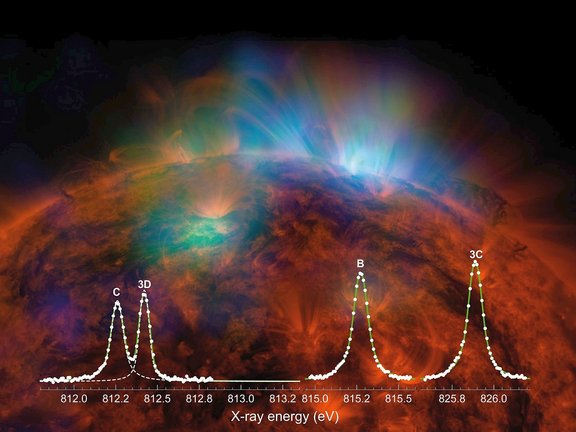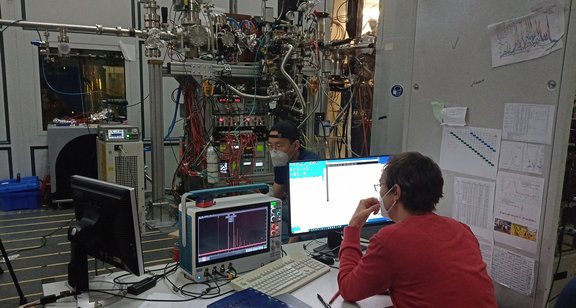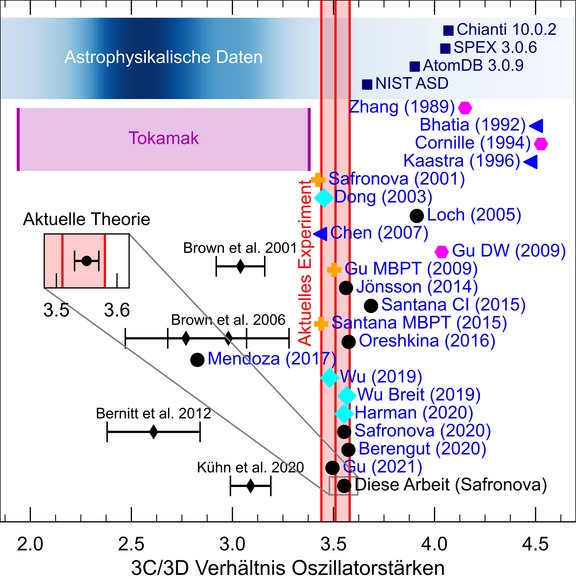Very hot gas, such as that existing in the corona of the sun or the close vicinity of black holes, emits intense X-ray radiation. It reveals which physical conditions, such as temperature and density, are present there. But for decades, researchers have been struggling with a problem: the intensity ratios of important radiation lines of iron measured in the laboratory do not match those calculated, and thus there is also uncertainty about the parameters of the gas derived from the X-ray spectra. An international team led by the Max Planck Institute for Nuclear Physics in Heidelberg has now solved the problem with an extraordinarily precise experiment: theory and experiment do at last coincide. As a result, X-ray data from space telescopes can be analysed in the future with a high degree of confidence in the atomic models behind them.
Almost everything we know about distant stars, gas nebulae and galaxies is based on the analysis of the light we receive from them. More precisely, of the electromagnetic waves, because astronomers now have their entire spectrum at hand. The spectral range in which a solid or a gas radiates most brightly depends mainly on its temperature: the hotter, the more energetic the radiation. In space, more than 99 per cent of all visible matter is in the plasma state; it is so hot that the atoms have lost one or more electrons and occur in the form of positively charged ions. For example, extremely hot plasmas with temperatures of more than one million degrees are present in the solar corona visible during a total solar eclipse. Furthermore, they are found in the vicinity of black holes or as intergalactic gas between galaxies.
The X-rays emitted by such plasmas exhibit the fingerprints of the chemical elements within them. Very prominent are spectral lines (emission lines) from multiply ionised iron, in particular Fe XVII, which has lost 16 of its original 26 electrons. The reason: Iron is common among the heavy elements and Fe XVII is present over a wide temperature range.
When analysing an X-ray spectrum, one compares not only the energies of the emission lines, but also the intensity ratios of characteristic lines. In order to be able to draw conclusions about the properties of the cosmic plasma, these intensity ratios must be well known. It is possible to do this by calculating them theoretically and verifying them experimentally in the laboratory. And that was just the problem so far: quantum mechanical calculations and laboratory results of the intensity ratios of two strong lines called 3C and 3D deviated from each other by about 20 percent and questioned our understanding of atomic structure as well as the confidence in the models used.
This was not only a headache for the astronomers, but also for the physicists, because where did the error lie, in the theory or the experiment? Two years ago, the team led by doctoral student Steffen Kühn at the Max Planck Institute for Nuclear Physics (MPIK) in Heidelberg had conducted the most accurate experiment to that date, and even then an inexplicable discrepancy remained. The MPIK theory team led by Natalia Oreshkina and Zoltan Harman, plus Marianna Safronova and Charles Cheung in the USA and Julian Berengut in Australia had run supercomputers at full blast to recalculate the emission lines 3C and 3D of Fe-XVII with the highest precision: The discrepancy as well as the question remained: Who was right?
“We were convinced to have all systematic effects known at that time under control,” Kühn remembers. However, in a final attempt, he and the research team led by José Crespo sought to get to the bottom of the matter: Instead of measuring the intensity ratio of the two lines, they tried to measure the absolute strength of the individual transitions, also called oscillator strength. But in order to measure these individual line strengths and identify the villain of the two lines in the theoretical observation, the quality of the measurement data had to be improved considerably.
For this tricky measurement, as part of his doctoral thesis Kühn used an Electron Beam Ion Trap apparatus (PolarX-EBIT) that had been built within the scope of a project by postdoc Sonja Bernitt at the MPIK. Inside it, iron ions are produced by an electron beam and trapped in a magnetic field. Thereby, the electron beam removes the outer electrons of the iron ions until the desired Fe XVII is present. Next, the trapped iron ions are irradiated with X-ray light of suitable energy such that they fluoresce. For this purpose, the incident energy of the X-ray photons has to be varied until the desired lines are exactly hit. Since commercially available sources cannot produce the X-ray radiation required, the PolarX-EBIT had to be transported to DESY in Hamburg. There, the PETRA III synchrotron generates an X-ray beam whose energy can be tuned over a specific energy range. This way, the iron ions are excited to emit X-rays, which are then spectrally analysed depending on the incident photon energy.
With clever improvements to the apparatus and the measurement scheme, Kühn and his colleagues Moto Togawa, René Steinbrügge and Chintan Shah succeeded during long days and short nights at the PETRAIII beamline in doubling the resolution of the spectra once more compared to their previous measurement and suppressing the interfering background, as it occurring in every measurement, by a factor of a thousand. The enormously improved data quality led to the breakthrough: for the first time, the emission lines to be investigated could be completely separated from neighbouring lines. Furthermore, lines 3C and 3D could now be measured right to their very edge. “In the previous measurements, the wings of these lines were hidden in the background, leading to an erroneous interpretation of the intensities,” explains Kühn. Maurice Leutenegger from NASA Goddard Space Flight Center, who was involved in the experiment as an expert in X-ray astrophysics, is also highly satisfied with the result: "The final outcome is now in excellent agreement with the theoretical predictions. That also pleases the theorists.
“This strengthens the confidence in the quantum mechanical calculations used to analyse astrophysical spectra. This applies particularly to lines for which there are no experimental reference values,” Kühn emphasises the significance of the new result. Moreover, the spectra of the space telescopes can now be evaluated with greater accuracy. This also applies to two large X-ray observatories that are soon to be launched into space: The Japanese-led X-Ray Imaging Spectroscopy Mission (XRISM, launch in May 2023) and the Athena X-Ray Observatory of the European Space Agency ESA (launch in the early 2030s).
[tb/mpik/mpg]
Original publication:
New Measurement Resolves Key Astrophysical Fe-XVII Oscillator Strength
Steffen Kühn, Charles Cheung, Natalia S. Oreshkina, René Steinbrügge, Moto Togawa, Sonja Bernitt, Lukas Berger, Jens Buck, Moritz Hoesch, Jörn Seltmann, Florian Trinter, Christoph H. Keitel, Mikhail G. Kozlov, Sergey G. Porsev, Ming Feng Gu, F. Scott Porter, Thomas Pfeifer, Maurice A. Leutenegger, Zoltán Harman, Marianna S. Safronova, José R. Crespo López-Urrutia and Chintan Shah
Physical Review Letters, 129, 245001, DOI: 10.1103/PhysRevLett.129.245001
Group Highly charged ion dynamics in the Division Pfeifer at MPIK
Group Ionic Quantum Dynamics and High-Precision Theory in the Division Keitel at MPIK
Free Electron Laser FLASH (DESY, Hamburg)
Physics Viewpoint: Getting a Clearer View of Iron Emission Lines, Roberto C. Mancini


